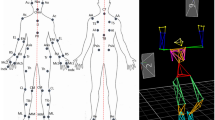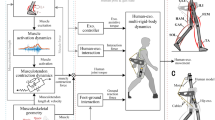Abstract.
The large mass of the human upper trunk, its elevated position during erect stance, and the small area limited by the size of the feet, stress the importance of equilibrium control during trunk movements. The objective of the present study was to perform a biomechanical analysis of fast forward trunk movements in order to understand the coordination between movement and posture. The analysis is based on a comparison between experimentally observed bending and hypothetical “optimal bending” performed on an infinitely narrow support, as presented in a companion paper. The experimental data were obtained from 16 subjects who performed fast forward bending while standing on a wide platform or on a narrow beam. The analysis is performed by decomposition of the movement into three dynamically independent components, each representing a movement along one of the three eigenvectors of the motion equation. The eigenmovements are termed “hip”, “ankle”, and “knee” eigenmovements, according to the dominant joint. The experimentally observed movement is characterized mainly by the hip and ankle eigenmovements, whereas the knee eigenmovement is negligible. Similarly to the “optimal bending” the ankle eigenmovement starts earlier and lasts longer than the hip eigenmovement. An early forward acceleration of the center of gravity in the ankle eigenmovement is caused by anticipatory changes in the ankle joint torque. This clarifies the role of the early tibialis anterior burst and/or soleus inhibition usually observed in electromyographic recordings during forward bending. The results suggest that the hip and the ankle eigenmovements can be treated as independently controlled motion units aimed at functionally different behavioral goals: the bending per se and postural adjustment. It is proposed that the central nervous system has to control these motion units sequentially in order to perform the movement and maintain equilibrium. It is also suggested that the hip and ankle eigenmovements can be regarded as a biomechanical background for the hip and ankle strategies introduced by Horak and Nashner (1986) on the basis of electromyographic recordings and kinematic patterns in response to postural perturbations.
Similar content being viewed by others
Author information
Authors and Affiliations
Additional information
Received: 1 July 1999 / Accepted in revised form: 23 October 2000
Rights and permissions
About this article
Cite this article
Alexandrov, A., Frolov, A. & Massion, J. Biomechanical analysis of movement strategies in human forward trunk bending. II. Experimental study. Biol Cybern 84, 435–443 (2001). https://doi.org/10.1007/PL00007987
Issue Date:
DOI: https://doi.org/10.1007/PL00007987




